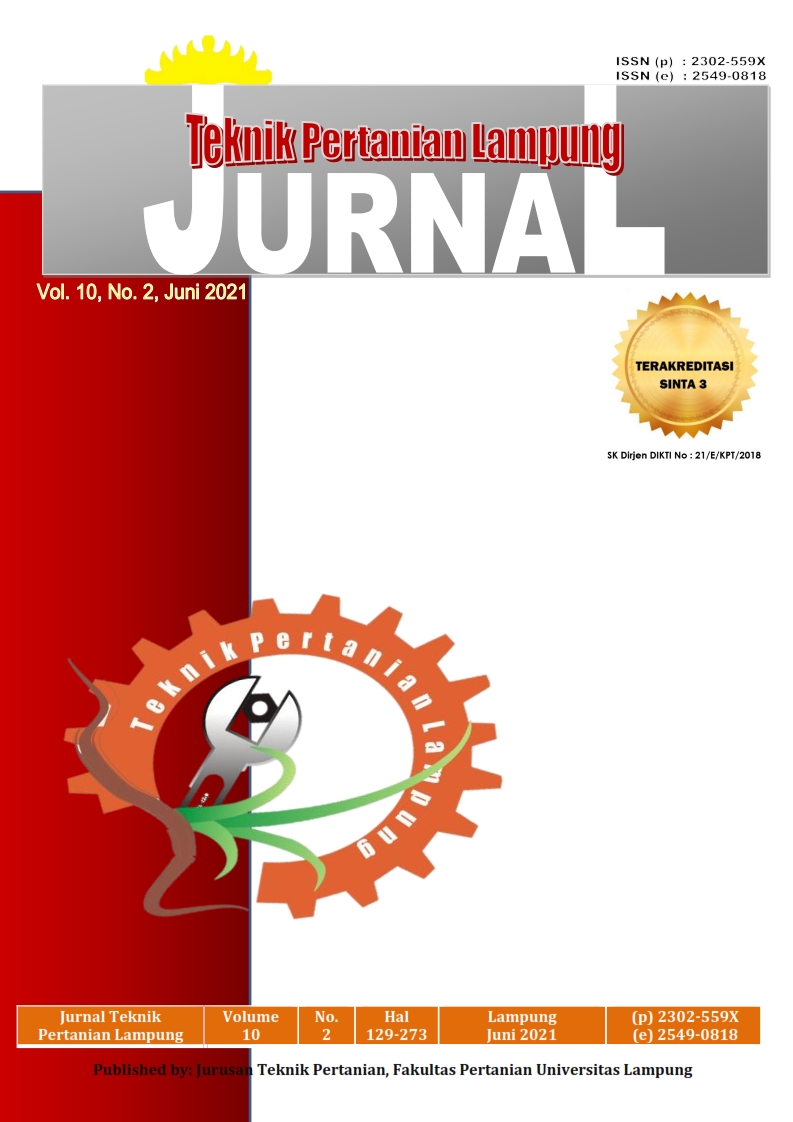PENGARUH METODE FERMENTASI DAN PENAMBAHAN URINE KELINCI TERHADAP KUALITAS PUPUK ORGANIK CAIR
DOI:
https://doi.org/10.23960/jtep-l.v10i2.139-146Abstract
The Minang Bangkit Merbabu Farmer Group use organic materials and produce their own liquid organic fertilizer. This liquid organic fertilizer is made of varied ingredients: rabbit urine, cow's milk, free-range chicken eggs, palm sugar, coconut water, pineapple, shrimp paste, bamboo roots, ginger, and turmeric. Composting is strongly affected by pH and aeration method. Liquid organic fertilizer made by farmers usually have an initial pH of around 3.7. This mixture was usually composted using semi-anaerobic method. Through this study, we wanted to find out whether different methods of aeration and addition of rabbit urine would result in different liquid organic fertilizer quality. The quality of liquid organic fertilizer includes C-organic, total nitrogen, total phosphorus and total potassium. The experiment was designed as a factorial randomized block design. There were 2 factors tested: rabbit urine volume and aeration method. There were two levels of rabbit urine volume : original and modified ones. There were three levels of aeration method: aerobic, semi-anaerobic, and anaerobic. In total, there were six treatments and four replication for each treatment. The results of the analysis showed that composting with the aerobic method at the original rabbit urine volume could increase the concentration of nutrient content so that it gave the highest yield. It is different from composting at a modified rabbit urine volume, because the highest yield is in the anaerobic method.
Keywords: aerated, organic, rabbit urine volume
References
Cooperband, L.R. 2000. Composting : Art and Science of Organic Waste Conversion to a Valuable Soil Resource. Laboratory Medicine, 31(6):203-209.
Hadisuwito, S. 2007. Membuat Pupuk Kompos Cair. Jakarta : Redaksi AgroMedia Pustaka.
Hermanus, M.B., Polii, B., dan Mandey, L.C. 2015. Pengaruh Perlakuan Aerob dan Anaerob Terhadap Variabel BOD, COD, pH dan Bakteri Dominan Limbah Industri Desiccated Coconut PT. Global Coconut Radey, Minahasa Selatan. Jurnal Ilmu dan Teknologi Pangan, 3(2) : 48-59.
Juanda, I. dan Nurdiana. 2011. Pengaruh metode dan lama fermentasi terhadap mutu Mikroorganisme lokal. Jurnal Floratek, 6:140-143.
Menteri Pertanian. 2019. Keputusan Menteri Pertanian Indonesia. No.261/KPTS/SR.310.M.4.2019 tentang Persyaratan Teknis Minimal Pupuk Organik, Pupuk Hayati, dan Pembenah Tanah.
Mulyani, H. 2014. Optimasi Perancangan Model Pengomposan. Jakarta : Trans Info Media.
Rina, D. 2015. Manfaat Unsur N, P, dan K bagi Tanaman. BPTP Kaltim (Balai Pengkajian Teknologi Pertanian Kalimantan Timur).
Rosniawaty, S., Sudirja, R., dan Afrianto, H. 2015. Pemanfaatan Urin Kelinci dan Urin Sapi Sebagai Alternatif Pupuk Organik Cair pada Pembibitan Kakao (Theobroma cacao L.). Jurnal Kultivasi, 14(1): 32-36.
Ruskandi. 2006. Pembuatan Kompos Limbah Kebun Pertanaman Kelapa Polikultur. Buletin Teknik Pertanian, 11(1):33-36.
Sajimin, Y., Rahardjo, C., dan Purwantari, N. D. 2010. Potensi Kotoran Kelinci sebagai Pupuk Organik dan Pemanfaatannya pada Tanaman Pakan dan Sayuran. Lokakarya Nasional Potensi dan Peluang Pengembangan Usaha Agribisnis Kelinci. Hal: 156 – 161.
Susetya, D. 2018. Panduan Lengkap Membuat Pupuk Organik Untuk Tanaman Pertanian dan Perkebunan. Yogyakarta : Pustaka Baru Press.
Sutanto, R. 2002. Penerapan Pertanian Organik. Yogyakarta: Kanisius.
Downloads
Published
Issue
Section
License
- Authors who publish with this journal agree to the following terms:
- Authors retain copyright and grant the journal right of first publication with the work simultaneously licensed under a Creative Commons Attribution-ShareAlike 4.0 International Lice that allows others to share the work with an acknowledgement of the work's authorship and initial publication in this journal.
- Authors are able to enter into separate, additional contractual arrangements for the non-exclusive distribution of the journal's published version of the work (e.g., post it to an institutional repository or publish it in a book), with an acknowledgement of its initial publication in this journal.
- Authors are permitted and encouraged to post their work online (e.g., in institutional repositories or on their website) prior to and during the submission process, as it can lead to productive exchanges, as well as earlier and greater citation of published work (See The Effect of Open Access).
Jurnal Teknik Pertanian Lampung

JTEPL is licensed under a Creative Commons Attribution-ShareAlike 4.0 International License.

